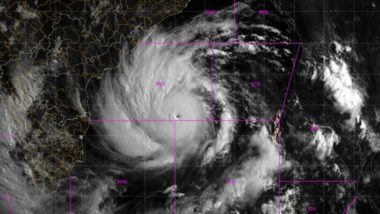New Delhi, December 6: Four of the five cyclones that originated either in the Bay of Bengal or in the Arabian Sea this year were in the category of severe cyclonic storm' or above including Amphan which had escalated into a super cyclone. Formation of cyclones is not uncommon in the Arabian Sea during the pre-monsoon period and in the Bay of Bengal during the post-monsoon months of October to December.
India Meteorological Department (IMD) Director General Mrutunjay Mohapatra said since 1990 four cyclones have formed every year in the seas along the eastern and western coasts (Bay of Bengal and Arabian Sea) of the country. “It is normal to have five cyclones a year,” he said. Cyclone Arnab Could Be Next Cyclonic Storm to Hit Tamil Nadu; Know How Cyclones Get Their Names.
'Amphan' was the first cyclone of the year. It formed in the Bay of Bengal and intensified into a 'super cyclonic storm', the first since the super cyclone of Odisha that had ravaged the state in 1999, killing thousands.
'Amphan', however, weakened a bit to become an 'extremely severe cyclonic storm' and slammed the coasts of West Bengal and Bangladesh on May 19.
Another circulation formed in the Arabian Sea within a fortnight, intensifying into a severe cyclonic storm which was called 'Nisarga'. The storm hit Alibag, near Mumbai, and helped monsoon to arrive in Kerala on its normal date of June 1.
Three cyclones – two in the Bay of Bengal and one in the Arabian Sea – have formed in the last one month. Cyclone 'Gati' intensified into a very severe cyclonic storm. It affected the western coast during its intensification stage, bringing rains over Kerala, but it crossed the Somalia coast on November 23.
Another cyclone was brewing in the Bay of Bengal at the same time.
Cyclone 'Nivar' was initially projected to be a 'severe cyclonic storm'. However, it intensified into a 'very severe cyclonic storm', crossing the Tamil Nadu coast on the night of November 25.
Less than a week later, another storm gathered momentum and intensified into a cyclonic storm. Cyclone 'Burevi' crossed the Sri Lanka coast on November 2 but as it crossed the south Tamil Nadu coast, having its intensity reduced to deep depression.
Cyclones not only bring violent winds, but rains accompanied by storm surge.
"A very severe cyclonic storm has a wind speed of 120-160 kilometres per hour and can uproot trees, partially damage communication lines and also damage thatched huts.
"An extremely severe cyclonic storm can lead to catastrophic damage, uproot power and communication lines and damage houses and other infrastructure," Mohapatra said. An extremely severe cyclonic storm has a wind speed of 160 to 220 kilometres per hour.
The IMD chief added the storm surge during Amphan was up to 10 metres when sea waters travelled inland. But will there be more cyclones in the remaining part of the month? "Not in the next seven days at least,” said Mohapatra. “We are monitoring the developments as the period between October-December is known for formation of cyclones,” he added.













 Quickly
Quickly


